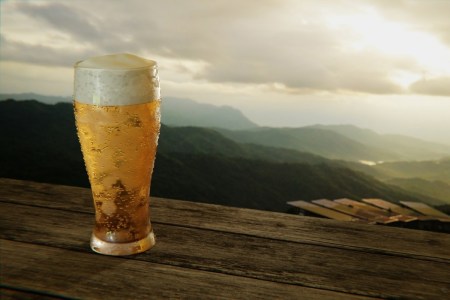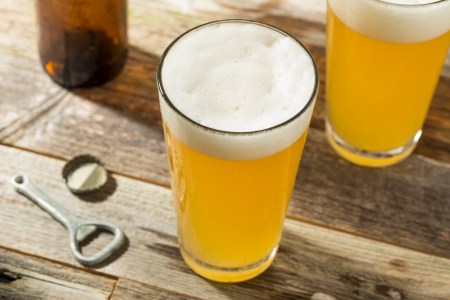
The style of a Cold IPA is not exactly new in terms of its qualities, but it deserves its own specific identity because of the way it is assembled and fermented.
The beer was conceived in a lager brewery as an IPA; but not as an IPL with that beer’s cold fermentation and hop character. It was the evolution of a West Coast IPA with the influence of Brut IPA (ie. formulated and fermented to be drier than normal) but fermented warm in a lager brewery with the house lager yeast.
So what is it?
Quite literally it’s an American Cream Ale brewed like an IPA. But what’s a Cream Ale you may ask? It’s an old style in the US, brewed both before and after Prohibition. That being said, I should also mention that the original American beer style was Adjunct Lager, which became the dominant beer style in the US by 1890. Adjunct lager was conceived in Germany in the mid 1800s and was brought to the US by German immigrants. While this beer style was not unusual in Germany at the time, it never really caught on due to its higher cost. The use of maize as an adjunct in conjunction with a double mash technique was subsequently granted a US patent in 1862. The double mash is essentially a double decoction or cereal mash that is still used today: corn grits are mashed at high temperatures with a portion of malted barley (63-75°C) to gelatinise and dextrinise the maize starch, brought to a boil and then added to a regular barley malt mash for complete saccharification. This was the birth of American Adjunct lager (AAL) and the beginning of the evolution of the style to what is now essentially 90 per cent of the beer brewed in the world today.
Historically, American Cream Ale was a natural sibling of AAL, being the same beer with the same lager yeast but fermented under ale temperatures and durations compared to the normal lager practices. Cream Ale has more esters than AAL and a softer character overall, but was otherwise identical to the lager beers of the day.
The current BJCP style guidelines for Cream ale cite an OG of 1.042-1.055, FG of 1.006-1.012 and 8-20 IBUs for an easy drinking beer, slightly sweet on the balance. Maize, rice, or simple sugars are typically used for up to 20 per cent of the grist, yielding a lighter body and high drinkability.
Cold IPA is brewed the same way but to higher gravity, OG 1.055-1.065 and 50-70 IBUs, more similar to typical West Coast IPA guidelines. The result is a lighter bodied, less estery West Coast IPA, that is not as dry as the Brut IPA, and doesn’t require exogenous enzymes.
The use of a lager yeast, like Fermentis SafLager W-34/70, is suggested, being fermented at warmer temperatures than typical for lager, but not necessarily as high as for an actual ale strain. The suggested pitching temperatures are 11-15°C, with a free rise to finish fermentation near 18°C. The finishing gravity typically comes in at 1.006-1.009.
Recipe formulation
For a Cold IPA this typically consists of pilsner malt or American 2 Row and 20 per cent of the grist as flaked maize. That’s it. The hop schedule includes a 60 minute boil addition to provide a solid base bitterness, followed by whirlpool (hot steeping) additions after the boil before chilling, and dry hopping. You can use any variety of hops that you prefer but I have tried to incorporate a little bit of US West Coast IPA with the Centennial. Aim for about 70 IBUs to keep it balanced. The yeast strain I recommend is the Weihenstephan lager yeast, not to be confused with the Weihenstephan Wheat beer yeast, commonly referred to as 34/70 or 3470. This strain ferments cleanly at ale temperatures with light esters but nothing strange. A Kolsch yeast strain will work as well. Ale pitching rates are used because of the warmer fermentation temperature.

India Cream Ale (Cold IPA) All Grain Recipe
(expected figures)
OG: 1.061
FG: 1.009
ABV: 7%
IBU: 75
Volume: 20 litres
Ingredients
4kg Pilsner malt
1kg Flaked corn (Maize)
70g Eclipse hop pellets
45g Galaxy hop pellets
45g Centennial hop pellets
Weihenstephan 34-70 Lager Yeast
Desired water profile
Ca2 50 – 75, Mg2 10 – 20, TA 0 – 50, SO4 50 – 100, Cl 50 – 100, RA -75 – 0
Method
1. Heat 26 litres to 69°C. You are shooting for a mash temperature of 65°C.
2. Immerse the grain bag in the water and stir the grist to ensure it is fully wetted.
3. Mash with occasional stirring for one hour.
4. Lift the grain bag out of the kettle and allow to drain. You should have 23 litres of 1.053 wort.
5. Bring to the boil, then add 25g Eclipse hops and boil for 60 minutes (to 20 litres).
6. At flameout, add 15g Eclipse, 15g Galaxy, 15g Centennial hops and steep/whirlpool for 20 to 30 minutes.
7. Chill the wort to 15°C and pitch the yeast.
8. After one week add 30g Eclipse, 30g Galaxy, and 30g Centennial to hop bag and add to fermenter.
9. Keg or bottle as usual.

John Palmer is the author of the bestselling home brew book How to Brew. In every issue of Beer & Brewer magazine he does a deep dive into a particular facet of brewing better beer and regularly provides one of his recipes. In the Autumn 2022 edition out March 1 he looks in depth at the red IPA. Subscribe to our magazine here.
